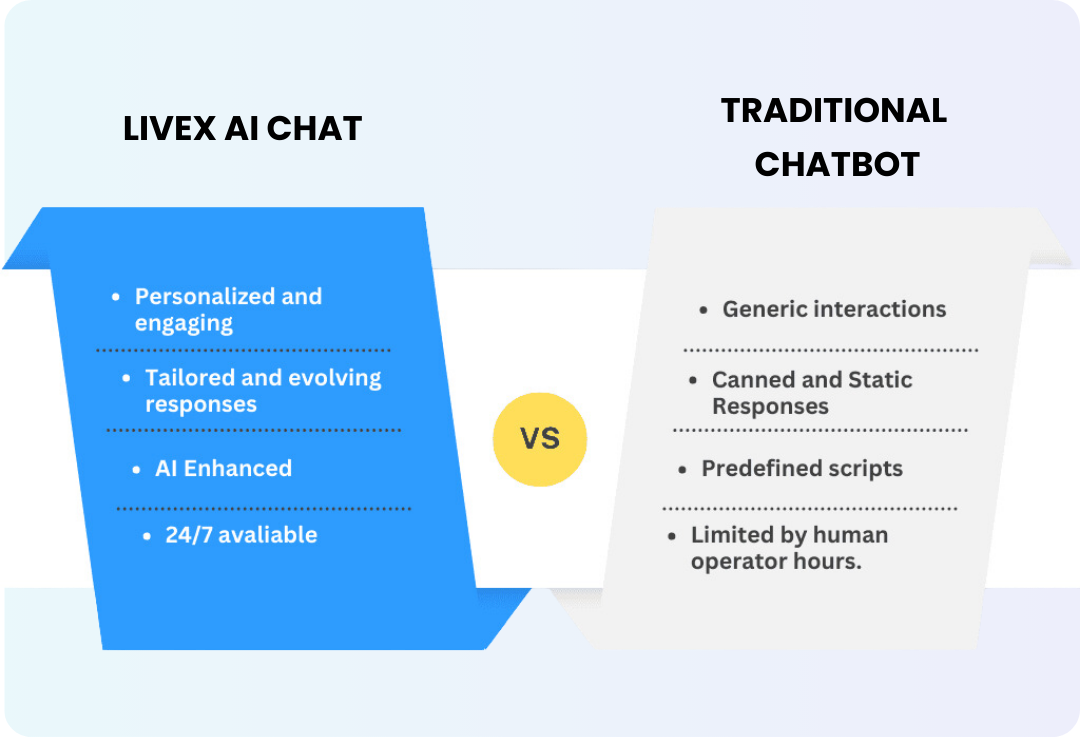How can you tell them apart? Think of a traditional AI chatbot like a jukebox—it plays exactly what you expect when you select a track. But Conversational AI? It's like a jazz musician—listening, adapting, and improving as it goes.
Want to know my quick way to spot a traditional AI chatbot? If you’re stuck typing instead of smoothly clicking buttons to keep the convo rolling, congrats—you’ve just encountered a classic chatbot in the wild!
In the dynamic world of digital customer engagement, terms like "Conversational Or Generative AI” and "AI Chatbot" often pop up. While they may sound similar, they are quite different in how they handle conversations and improve customer interactions.

Understanding AI Chatbot Technology
Chatbots or AI chatbots are basic tools in digital customer service. They follow specific rules and use predefined scripts to answer questions. If you ask something simple, like "What are your business hours?" they know exactly what to say. But if things get a bit more complicated or personal, they're not so great. This can make some interactions with them very underwhelming.
What is Conversational AI or Generative AI?
Conversational AI is the smarter cousin here. It uses something called a Large Language Model (LLM) to chat in a way that feels surprisingly human. Unlike the basic chatbots, this type of AI understands the flow of natural language better, can handle varied responses, and adapts to the conversation as it happens. This makes it a much better fit for businesses that need to have deeper, more meaningful communications with their customers.

Key Features of Conversational AI
- Generative AI Chatbot Capabilities: Conversational AI uses its language understanding superpower to figure out what people mean, not just what they say. It can come up with new, appropriate responses on the fly, making each interaction unique.
- Learning and Adapting: This AI gets smarter over time. It learns from every conversation, constantly getting better at predicting what your customers need and personalizing chats to suit them.
- Remembering Context: It’s good at keeping track of what was said before in the conversation. This helps it make sense of the chat as it unfolds, just like talking to a human.
- Starting Conversations: It doesn’t just wait around for questions; it can start offering help based on what it thinks your customers might need next. This proactive approach can prevent problems and keep customers happy.
Pricing Models: Chatbots vs. Conversational AI
When it comes to pricing, traditional chatbots usually offer a straightforward monthly subscription, allowing unlimited use without worrying about extra costs. On the other hand, Generative AI chatbots typically follow a usage-based pricing model, where you're charged based on how much you use the service. This means you pay according to the interactions or processing power required, offering more flexibility and scalability as your needs grow.
LiveX AI’s AI Agent in Action
Our AI Chat at LiveX AI demonstrates what Conversational AI can do:
- Smooth Integration Across Platforms: It fits right into different messaging platforms, keeping the customer experience seamless wherever the conversation starts.
- Handling Complex Questions: It manages tricky questions with ease, providing answers that are clear and to the point.
- Anticipating Needs: It's not just reactive; it tries to guess what customers will need before they even ask, setting a new standard for proactive customer service.
Why Conversational AI Is a Strategic Asset
Integrating Conversational AI into your service strategy turns simple transactions into real connections. As Forbes puts it, “while traditional AI excels at pattern recognition, generative AI excels at pattern creation.” This means it doesn’t just use data to answer questions—it uses data to start new conversations and build relationships, offering highly tailored and timely interactions.
By choosing Conversational AI, you boost your business’s ability to deliver outstanding, personalized service that meets the high expectations of today's customers, ensuring their loyalty and setting your brand apart. This move puts your business ahead in the digital customer engagement game, ready to lead and innovate.
Conclusion: From Jukeboxes to Jazz—Evolving with Conversational AI
Just like moving from a jukebox to a jazz band, upgrading from traditional chatbots to Conversational AI means bringing a new level of spontaneity and sophistication to your customer interactions. No longer are you restricted to the same old tracks; now, you can improvise, adapt, and truly engage with your audience in real time. Imagine your business not just responding to questions but starting meaningful conversations and playing the tune of customer satisfaction like a smooth jazz riff. With Conversational AI, you're not just playing background music—you're creating a memorable experience that keeps your customers coming back for more.
